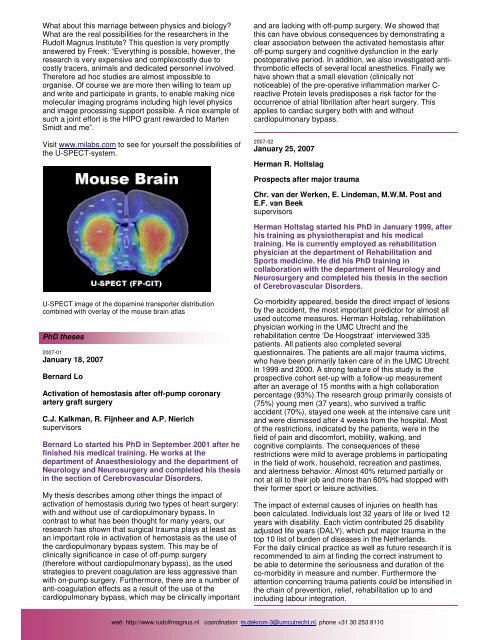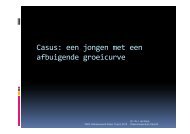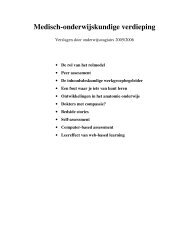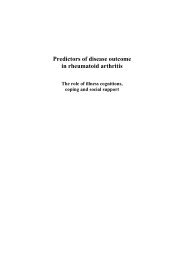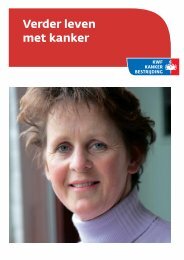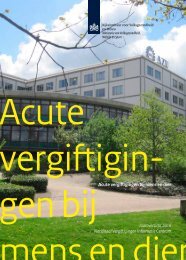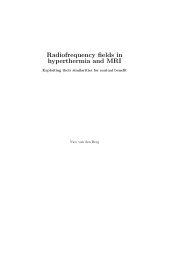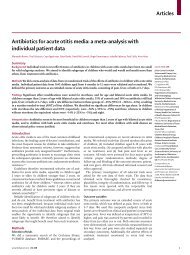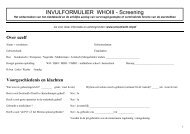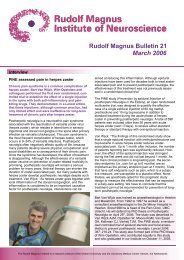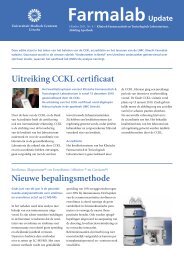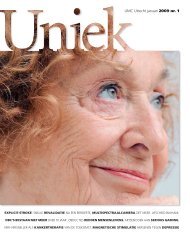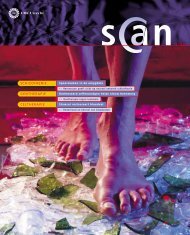Rudolf Magnus Bulletin 29 February 2007 - UMC Utrecht
Rudolf Magnus Bulletin 29 February 2007 - UMC Utrecht
Rudolf Magnus Bulletin 29 February 2007 - UMC Utrecht
You also want an ePaper? Increase the reach of your titles
YUMPU automatically turns print PDFs into web optimized ePapers that Google loves.
What about this marriage between physics and biology?<br />
What are the real possibilities for the researchers in the<br />
<strong>Rudolf</strong> <strong>Magnus</strong> Institute? This question is very promptly<br />
answered by Freek: “Everything is possible, however, the<br />
research is very expensive and complexcostly due to<br />
costly tracers, animals and dedicated personnel involved.<br />
Therefore ad hoc studies are almost impossible to<br />
organise. Of course we are more then willing to team up<br />
and write and participate in grants, to enable making nice<br />
molecular imaging programs including high level physics<br />
and image processing support possible. A nice example of<br />
such a joint effort is the HIPO grant rewarded to Marten<br />
Smidt and me”.<br />
Visit www.milabs.com to see for yourself the possibilities of<br />
the U-SPECT-system.<br />
and are lacking with off-pump surgery. We showed that<br />
this can have obvious consequences by demonstrating a<br />
clear association between the activated hemostasis after<br />
off-pump surgery and cognitive dysfunction in the early<br />
postoperative period. In addition, we also investigated antithrombotic<br />
effects of several local anesthetics. Finally we<br />
have shown that a small elevation (clinically not<br />
noticeable) of the pre-operative inflammation marker C-<br />
reactive Protein levels predisposes a risk factor for the<br />
occurrence of atrial fibrillation after heart surgery. This<br />
applies to cardiac surgery both with and without<br />
cardiopulmonary bypass.<br />
<strong>2007</strong>-02<br />
January 25, <strong>2007</strong><br />
Herman R. Holtslag<br />
Prospects after major trauma<br />
Chr. van der Werken, E. Lindeman, M.W.M. Post and<br />
E.F. van Beek<br />
supervisors<br />
Herman Holtslag started his PhD in January 1999, after<br />
his training as physiotherapist and his medical<br />
training. He is currently employed as rehabilitation<br />
physician at the department of Rehabilitation and<br />
Sports medicine. He did his PhD training in<br />
collaboration with the department of Neurology and<br />
Neurosurgery and completed his thesis in the section<br />
of Cerebrovascular Disorders.<br />
U-SPECT image of the dopamine transporter distribution<br />
combined with overlay of the mouse brain atlas<br />
PhD theses<br />
<strong>2007</strong>-01<br />
January 18, <strong>2007</strong><br />
Bernard Lo<br />
Activation of hemostasis after off-pump coronary<br />
artery graft surgery<br />
C.J. Kalkman, R. Fijnheer and A.P. Nierich<br />
supervisors<br />
Bernard Lo started his PhD in September 2001 after he<br />
finished his medical training. He works at the<br />
department of Anaesthesiology and the department of<br />
Neurology and Neurosurgery and completed his thesis<br />
in the section of Cerebrovascular Disorders.<br />
My thesis describes among other things the impact of<br />
activation of hemostasis during two types of heart surgery:<br />
with and without use of cardiopulmonary bypass. In<br />
contrast to what has been thought for many years, our<br />
research has shown that surgical trauma plays at least as<br />
an important role in activation of hemostasis as the use of<br />
the cardiopulmonary bypass system. This may be of<br />
clinically significance in case of off-pump surgery<br />
(therefore without cardiopulmonary bypass), as the used<br />
strategies to prevent coagulation are less aggressive than<br />
with on-pump surgery. Furthermore, there are a number of<br />
anti-coagulation effects as a result of the use of the<br />
cardiopulmonary bypass, which may be clinically important<br />
Co-morbidity appeared, beside the direct impact of lesions<br />
by the accident, the most important predictor for almost all<br />
used outcome measures. Herman Holtslag, rehabilitation<br />
physician working in the <strong>UMC</strong> <strong>Utrecht</strong> and the<br />
rehabilitation centre ‘De Hoogstraat’ interviewed 335<br />
patients. All patients also completed several<br />
questionnaires. The patients are all major trauma victims,<br />
who have been primarily taken care of in the <strong>UMC</strong> <strong>Utrecht</strong><br />
in 1999 and 2000. A strong feature of this study is the<br />
prospective cohort set-up with a follow-up measurement<br />
after an average of 15 months with a high collaboration<br />
percentage (93%).The research group primarily consists of<br />
(75%) young men (37 years), who survived a traffic<br />
accident (70%), stayed one week at the intensive care unit<br />
and were dismissed after 4 weeks from the hospital. Most<br />
of the restrictions, indicated by the patients, were in the<br />
field of pain and discomfort, mobility, walking, and<br />
cognitive complaints. The consequences of these<br />
restrictions were mild to average problems in participating<br />
in the field of work, household, recreation and pastimes,<br />
and alertness behavior. Almost 40% returned partially or<br />
not at all to their job and more than 60% had stopped with<br />
their former sport or leisure activities.<br />
The impact of external causes of injuries on health has<br />
been calculated. Individuals lost 32 years of life or lived 12<br />
years with disability. Each victim contributed 25 disability<br />
adjusted life years (DALY), which put major trauma in the<br />
top 10 list of burden of diseases in the Netherlands.<br />
For the daily clinical practice as well as future research it is<br />
recommended to aim at finding the correct instrument to<br />
be able to determine the seriousness and duration of the<br />
co-morbidity in measure and number. Furthermore the<br />
attention concerning trauma patients could be intensified in<br />
the chain of prevention, relief, rehabilitation up to and<br />
including labour integration.<br />
web http://www.rudolfmagnus.nl coordination m.dekrom-3@umcutrecht.nl, phone +31 30 253 8110


